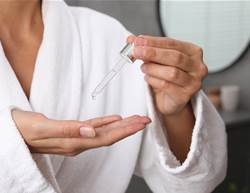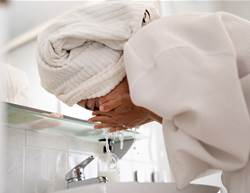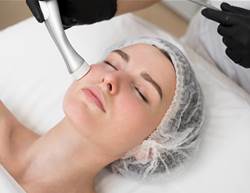Having dry skin is bad enough, but when cracked heels come into the picture? Let's just say walking around all day with painful fissures long isn't fun. While dry skin is the primary cause of cracked heels, it's not the only culprit.
Prolonged standing, wearing shoes or sandals with open backs, having calluses, and being obese puts pressure on the heels, causing the skin to split. Some cracks are minor, but more severe cases can lead to bleeding, discomfort, and pain-especially if bacteria seeps into the fissures. That’s why it’s important to take care of the problem ASAP before things get worse. Here are some simple ways to soothe your cracked heels and give them some much-needed relief. You’ll be back on your feet and feeling good in no time.
Up your water intake
When you’re experiencing cracked heels, don’t just immediately tend to your feet-grab a water bottle, fill it up, and start guzzling. “Make sure you’re drinking enough water,” says podiatrist Garrett Moore. “Your skin can lose around a litre of water throughout the day-more in dry climates-so keeping yourself hydrated goes a long way toward preventing or soothing dry, cracked skin,” he says.
Stay moisturised
Whether you’re trying to prevent cracked heels or heal them, the solution is the same: stay moisturised. “Use a good moisturiser at least once a day, possibly more. While there are various moisturisers and barrier creams out there-and many reasons to use certain types-one of the biggest problems I run into with patients is lack of consistency,” Moore says. “Moisturiser needs to be applied to the feet daily-once in the morning and once at night before bed. This will help you keep fluids in your skin, minimise loss, and even attract more from the underlying tissues (or even the surrounding environment!).”
Consistency in the products you use is also important. According to Moore, choosing either lotions or creams-and sticking with that choice-will “keep the skin from the cycling that can actually cause the cracking in the first place.”
Avoid petroleum jelly
It’s common to reach for products like Vaseline to help soothe your cracked heels, but Moore advises against it. “I tend to ask patients to avoid petroleum jelly-based products,” he says. “While occlusive products can prevent moisture loss, you don’t want to completely cut off moisture passing through the skin in an everyday setting.” Occlusive products, like petroleum jelly stay on the skin and aren't well absorbed. Instead, keep reaching for those lotions or creams, which can get the job done without any negatives.
Get intensive healing cream, if you need it
Sometimes when your cracked heels are severe, normal lotions won’t do the trick-and that’s when you have to bring in the big guns. “If proper, frequent application of high-quality over-the-counter products isn’t preventing fissures, check with your doctor. Sometimes there can be a fungus exacerbating the problem,” Moore says. “If it’s truly just dry skin, we can prescribe emollients-such as ammonium lactate or urea cream-to get your skin healthy, then switch you to a lotion for maintaining that health.”
There are also options with urea you can get from the pharmacy without a prescription, but maybe not quite as strong. “Urea is a keratolytic agent, meaning it helps to chemically exfoliate dead skin, leaving your feet soft and smooth. It's not only great for callused feet, but it can also be used to smooth out rough elbows and knees,” dermatologist Dr Roberta Del Campo says.
Wear closed-back shoes
Since shoes and sandals with open backs can cause cracked heels-and make them worse!-make sure you have a trusty pair of closed options to wear when you’re having issues, even if that’s just some sneakers. “Protect the area by wearing closed-back shoes and socks,” says dermatologist Dr Dendy Engelman.
Don't peel or shave your calluses
When you notice your heels peeling, it’s really hard not to pick at it. But it’s the worst thing you can do for the health of your feet. “Never try to peel off dead skin by hand, or attempt to shave a callus yourself. I call this ‘performing bathroom surgery,’ and it’s a great way to get a very bad infection,” Moore says. In reality, your doctor should be the only one messing with your foot issues because they know exactly what they’re doing and won’t make the problem worse. “I’m using sterile instruments in a clean environment. I’m also able to see your feet at a much clearer angle to only remove what’s necessary without unwanted complications,” he explains.
Buy moisturising socks
If you want to go beyond just wearing your normal everyday socks to protect your heels, get some extra moisturising benefits by grabbing a pair made especially for those dry cracks. The bonus? Your entire foot will reap the softening benefits-not just your heels.
Use a foot soak
Soak your feet and get rid of dead skin-but only after the cracks have healed. “When exfoliating calluses, I recommend a foot soak,” Dr Engelman says. There are plenty of store-bought options but you can also use items you already have right at home. “You can add milk and honey to soften calluses before exfoliating. This helps soften the skin so you’re not vigorously scrubbing. When it starts feeling sensitive, slow down as you don’t want to overexfoliate.”
Exfoliate with a pumice stone
When you’re exfoliating after your foot soak, the best thing you can use is a pumice stone. “It helps keep any dry areas or calluses down. While calluses can be protective, when they get too thick, they can lose all flexibility and crack when you move,” Dr Engelman says. Just make sure you keep things clean. “If you use a pumice stone periodically-once every couple of weeks-soak the stone in some cleanser or bleach, then rinse it well. Those crevices that make it such a natural skin file can fill up with dead skin and provide a home for bacteria.”










